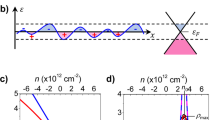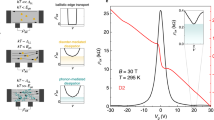Abstract
In electronic transport, umklapp processes play a fundamental role as the only intrinsic mechanism that allows electrons to transfer momentum to the crystal lattice and, therefore, provide a finite electrical resistance in pure metals1,2. However, umklapp scattering is difficult to demonstrate in experiment, as it is easily obscured by other dissipation mechanisms1,2,3,4,5,6. Here we show that electron–electron umklapp scattering dominates the transport properties of graphene-on-boron-nitride superlattices over a wide range of temperature and carrier density. The umklapp processes cause giant excess resistivity that rapidly increases with increasing superlattice period and are responsible for deterioration of the room-temperature mobility by more than an order of magnitude as compared to standard, non-superlattice graphene devices. The umklapp scattering exhibits a quadratic temperature dependence accompanied by a pronounced electron–hole asymmetry with the effect being much stronger for holes than electrons. In addition to being of fundamental interest, our results have direct implications for design of possible electronic devices based on heterostructures featuring superlattices.
This is a preview of subscription content, access via your institution
Access options
Access Nature and 54 other Nature Portfolio journals
Get Nature+, our best-value online-access subscription
$29.99 / 30 days
cancel any time
Subscribe to this journal
Receive 12 print issues and online access
$209.00 per year
only $17.42 per issue
Buy this article
- Purchase on Springer Link
- Instant access to full article PDF
Prices may be subject to local taxes which are calculated during checkout



Similar content being viewed by others
Data availability
The data that support plots within this paper and other findings of this study are available from the corresponding author upon reasonable request.
References
Bass, J., Pratt, W. P. & Schroeder, P. A. The temperature-dependent electrical resistivities of the alkali metals. Rev. Mod. Phys. 62, 645–744 (1990).
Gasparov, V. A. & Huguenin, R. Electron–phonon, electron–electron and electron–surface scattering in metals from ballistic effects. Adv. Phys. 42, 393–521 (1993).
Messica, A. et al. Suppression of conductance in surface superlattices by temperature and electric field. Phys. Rev. Lett. 78, 705–708 (1997).
Overend, N. et al. Giant magnetoresistance and possible miniband effects in periodic magnetic fields. Physica B 249–251, 326–329 (1998).
Kato, M., Endo, A., Katsumoto, S. & Iye, Y. Two-dimensional electron gas under a spatially modulated magnetic field: A test ground for electron–electron scattering in a controlled environment. Phys. Rev. B 58, 4876–4881 (1998).
Kato, M., Endo, A., Sakairi, M., Katsumoto, S. & Iye, Y. Electron–electron Umklapp process in two-dimensional electron gas under a spatially alternating magnetic field. J. Phys. Soc. Jpn 68, 1492–1495 (1999).
Kashuba, A. B. Conductivity of defectless graphene. Phys. Rev. B 78, 085415 (2008).
Fritz, L., Schmalian, J., Müller, M. & Sachdev, S. Quantum critical transport in clean graphene. Phys. Rev. B 78, 085416 (2008).
Nam, Y., Ki, Dong-Keun, K., Soler-Delgado, D. & Morpurgo, A. F. Electron–hole collision limited transport in charge-neutral bilayer graphene. Nat. Phys. 13, 1207–1214 (2017).
Rice, T. M., Robinson, N. J. & Tsvelik, A. M. Umklapp scattering as the origin of T-linear resistivity in the normal state of high-T c cuprate superconductors. Phys. Rev. B 96, 220502 (2017).
Aleiner, I. L. & Agam, O. Saturation of strong electron–electron umklapp scattering at high temperature. Ann. Phys. 385, 716–728 (2017).
Lee, M. et al. Ballistic miniband conduction in a graphene superlattice. Science 353, 1526–1529 (2016).
Wallbank, J. R., Patel, A. A., Mucha-Kruczyński, M., Geim, A. K. & Fal’ko, V. I. Generic miniband structure of graphene on a hexagonal substrate. Phys. Rev. B 87, 245408 (2013).
Wallbank, J. R., Mucha-Kruczyński, M., Xi, C. & I., F. V. Moiré superlattice effects in graphene/boron‐nitride van der Waals heterostructures. Ann. Phys. 527, 359–376 (2015).
Yankowitz, M. et al. Emergence of superlattice Dirac points in graphene on hexagonal boron nitride. Nat. Phys. 8, 382–386 (2012).
Krishna Kumar, R. et al. High-temperature quantum oscillations caused by recurring Bloch states in graphene superlattices. Science 357, 181–184 (2017).
Wang, E. et al. Gaps induced by inversion symmetry breaking and second-generation Dirac cones in graphene/hexagonal boron nitride. Nat. Phys. 12, 1111–1115 (2016).
Wang, E. et al. Electronic structure of transferred graphene/h-BN van der Waals heterostructures with nonzero stacking angles by nano-ARPES. J. Phys. Condens. Matter 28, 444002 (2016).
Hwang, E. H. & Das Sarma, S. Acoustic phonon scattering limited carrier mobility in two-dimensional extrinsic graphene. Phys. Rev. B 77, 115449 (2008).
Hwang, E. H. & Das Sarma, S. Dielectric function, screening, and plasmons in two-dimensional graphene. Phys. Rev. B 75, 205418 (2007).
Ziman, J. M. Electrons And Phonons: The Theory of Transport Phenomena in Solids Sec. 9.14 (Oxford Univ. Press, Oxford, 1960).
Castro Neto, A. H., Guinea, F., Peres, N. M. R., Novoselov, K. S. & Geim, A. K. The electronic properties of graphene. Rev. Mod. Phys. 81, 109–162 (2009).
DaSilva, A. M., Jung, J., Adam, S. & MacDonald, A. H. Transport and particle–hole asymmetry in graphene on boron nitride. Phys. Rev. B 91, 245422 (2015).
Chen, J.-H., Jang, C., Xiao, S., Ishigami, M. & Fuhrer, M. S. Intrinsic and extrinsic performance limits of graphene devices on SiO2. Nat. Nanotech. 3, 206–209 (2008).
Wang, L. et al. One-dimensional electrical contact to a two-dimensional material. Science 342, 614–617 (2013).
Yang, W. et al. Epitaxial growth of single-domain graphene on hexagonal boron nitride. Nat. Mater. 12, 792–797 (2013).
Lopes dos Santos, J. M. B., Peres, N. M. R. & Castro Neto, A. H. Graphene bilayer with a twist: electronic structure. Phys. Rev. Lett. 99, 256802 (2007).
Bistritzer, R. & MacDonald, A. H. Transport between twisted graphene layers. Phys. Rev. B 81, 245412 (2010).
Li, G. et al. Observation of Van Hove singularities in twisted graphene layers. Nat. Phys. 6, 109–113 (2010).
Kim, K. et al. Tunable moiré bands and strong correlations in small-twist-angle bilayer graphene. Proc. Natl Acad. Sci. USA 114, 3364–3369 (2017).
Sanchez-Yamagishi, J. D. et al. Quantum Hall effect, screening, and layer-polarized insulating states in twisted bilayer graphene. Phys. Rev. Lett. 108, 076601 (2012).
Rode, J. C., Smirnov, D., Schmidt, H. & Haug, R. J. Berry phase transition in twisted bilayer graphene. 2D Mater. 3, 035005 (2016).
Cao, Y. et al. Unconventional superconductivity in magic-angle graphene superlattices. Nature 556, 43–50 (2018).
Mayorov, A. S. et al. Micrometer-scale ballistic transport in encapsulated graphene at room temperature. Nano Lett. 11, 2396–2399 (2011).
Kretinin, A. V. et al. Electronic properties of graphene encapsulated with different two-dimensional atomic crystals. Nano Lett. 14, 3270–3276 (2014).
Woods, C. R. et al. Commensurate–incommensurate transition in graphene on hexagonal boron nitride. Nat. Phys. 10, 451–456 (2014).
Ben Shalom, M. et al. Quantum oscillations of the critical current and high-field superconducting proximity in ballistic graphene. Nat. Phys. 12, 318–322 (2015).
Ponomarenko, L. A. et al. Cloning of Dirac fermions in graphene superlattices. Nature 497, 594–597 (2013).
Dean, C. R. et al. Hofstadter’s butterfly and the fractal quantum Hall effect in moiré superlattices. Nature 497, 598–602 (2013).
Hunt, B. et al. Massive Dirac fermions and Hofstadter butterfly in a van der Waals heterostructure. Science 340, 1427–1430 (2013).
Acknowledgements
We would like to thank C. Woods, S. Slizovskiy and F. Guinea for useful discussions. This work was supported by the European Research Council Synergy Grant and Advanced Investigator Grant, Lloyd’s Register Foundation Nanotechnology Grant, EC European Graphene Flagship Project, the Royal Society and EPSRC (including the EPSRC CDT NOWNANO).
Author information
Authors and Affiliations
Contributions
This study was consummated by J.R.W., V.I.F. and A.K.G.; J.R.W, I.L.A and V.I.F. have developed theory for the studied effect. hBN was provided by T.T. and K.W. The devices were fabricated by M.H., G.H.A. and J.B. Transport measurements were performed by R.K.K., Z.W. and A.M. under the supervision of K.S.N., L.A.P. and A.K.G. All authors have contributed to the discussions of results. The manuscript was written by J.R.W, R.K.K., V.I.F. and A.K.G.
Corresponding author
Ethics declarations
Competing interests
The authors declare no competing interests.
Additional information
Publisher’s note: Springer Nature remains neutral with regard to jurisdictional claims in published maps and institutional affiliations.
Supplementary information
Supplementary Information
Supplementary Figures 1–5; Supplementary References 1–18; Additional mathematical derivations
Rights and permissions
About this article
Cite this article
Wallbank, J.R., Krishna Kumar, R., Holwill, M. et al. Excess resistivity in graphene superlattices caused by umklapp electron–electron scattering. Nature Phys 15, 32–36 (2019). https://doi.org/10.1038/s41567-018-0278-6
Received:
Accepted:
Published:
Issue Date:
DOI: https://doi.org/10.1038/s41567-018-0278-6
This article is cited by
-
Higher order gaps in the renormalized band structure of doubly aligned hBN/bilayer graphene moiré superlattice
Nature Communications (2024)
-
Electrically driven amplification of terahertz acoustic waves in graphene
Nature Communications (2024)
-
A magnetically-induced Coulomb gap in graphene due to electron-electron interactions
Communications Physics (2023)
-
Mixing of moiré-surface and bulk states in graphite
Nature (2023)
-
Graphene moiré superlattices with giant quantum nonlinearity of chiral Bloch electrons
Nature Nanotechnology (2022)



